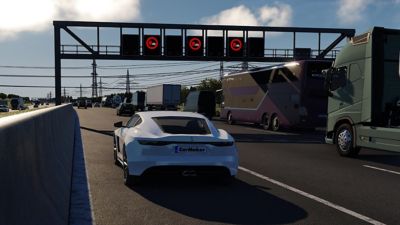-
-
Access Free Student Software
Ansys empowers the next generation of engineers
Students get free access to world-class simulation software.
-
Connect with Ansys Now!
Design your future
Connect with Ansys to explore how simulation can power your next breakthrough.
Countries & Regions
Free Trials
Products & Services
Learn
About
Back
Products & Services
Back
Learn
Ansys empowers the next generation of engineers
Students get free access to world-class simulation software.
Back
About
Design your future
Connect with Ansys to explore how simulation can power your next breakthrough.
Free Trials
ANSYS BLOG
September 15, 2022
Driving Smarts: Is Robust Vehicle Perception Here?
Yielding greater insights by bringing together sensor performance and the environment they respond to
When it comes to advanced driver assistance systems (ADAS) and autonomous vehicle (AV) perception, external driving environments do not follow hard and fast rules. This is true whether you’re cruising up the north coast of California or maneuvering through congested city streets in the Ginza district in Tokyo. Ever-changing driving dynamics like these present unique challenges for manufacturers who are working to deliver accurate, real-time perception for ADAS and AVs.
The artificial intelligence (AI) and machine learning (ML) that facilitate ADAS and AV perception is enabled by data. Enormous amounts of ADAS and AV system data intelligence must be collected by sensors during billions of hours of virtual drive time to guide and validate system safety. This sensor data is what informs system perception, so it must be incredibly robust to enable these technologies in response to various weather conditions, road hazards, and many other driving situations.
Of course, sensor performance can be simulated in isolation. But to really understand ADAS and AV system behavior, the sensor performance should also be simulated in the context of a virtual environment. To take on these challenges, automakers are turning to solutions which enable them to simulate both the physical properties of components and real-time system behavior to make advancements in the safety and reliability of ADAS and AV features.

Teaming up to Deliver Unrivaled Simulation Capabilities
An entirely new field of variations and possibilities in ADAS and AV testing, certification, and validation opens up when you connect sensor simulation with a virtual test platform. Through this pairing of technologies, manufacturers can run extensive sensor testing on a larger scale and find efficiencies through the use and reuse of sensor models.
Through the encouragement of automotive suppliers such as Valeo, Ansys and IPG Automotive teamed up to deliver a combined workflow that enables more robust testing and validation of ADAS and AV systems. Thanks to the partnership and its open application programming interface (API), Ansys' high-fidelity physics-based sensor simulator AVxcelerate now comes with a connector to IPG Automotive’s CarMaker.
“One main driver for cooperation, or the main motivation for both Ansys and IPG Automotive, is probably the increasing dynamic of complex requirements regarding ADAS,” says Ralf Sauer, vice president of Marketing & Communications at IPG Automotive. “It’s important to find powerful strategic partners like Ansys to increase your agility in the space and connect your customers with a complete solution. Bringing both companies together is really the best way to leverage the value of simulation to align sensor performance expectations in an almost infinite number of driving environments.”
Operating within this co-simulation architecture enables seamless synchronization between Ansys and IPG Automotive simulation platforms, as well as camera, radar, and lidar data capture. Real-time data produced by sensor simulation is then streamed to perception algorithms, enabling testing of the full ADAS/AD software stack. Ultimately the resulting data can be used in considering scenario, traffic, and vehicle dynamics, as well as qualified multispectral material properties of the environment.
This capability also enables unscripted edge case testing and correction through simulation. As you drive in and out of the shadows of tall buildings that comprise an urban cityscape, for example, changes in exposure of a light-sensitive vehicle camera must be accounted for to avoid oversaturation and a subsequent loss of contrast that could impede ADAS and AV system functionality.

Leading the way With Flexibility
What compounds ADAS and AV design challenges is the ever-growing complexity of the technologies themselves. Feature verification and validation based on this cooperative approach to simulation enables manufacturers to be flexible and respond to changing market conditions, including a dynamic regulation environment. Using high-performance computing (HPC) in the cloud enables manufacturers to easily run millions of test miles overnight, supporting higher testing and validation quality.
“It definitely helps to have a good setup already in place — a base to be able to work from in the future,” says Marina Liebich, business development manager at IPG Automotive. “I think this partnership is able to support that. While we have no hard facts yet, today we have already demonstrated that we can manage and handle a lot of the workload for what will be a massive amount of testing efforts in the future. Using simulation, we’re able to test a lot of aspects of these systems and catch anything that goes wrong early in the development process, and I think that’s a major benefit.”
The partnership also helped to break down silos by creating more fluid boundaries around product development. In response to customers, automotive suppliers are stretched to come up with innovative, new ways to develop functions and components that satisfy different verticals, requiring teams to step out of their traditional roles to tackle new challenges. It’s an industry tendency that is rapidly evolving as we move toward fully autonomous vehicle development.
“I think this partnership is really a way to leverage our capabilities and increase flexibility during development,” says Liebich. “It's difficult for one company to solve all the customer problems out there at the moment, or to solve them quickly. Bringing both possibilities together increased flexibility in simulation and testing and enabled both Ansys and IPG Automotive to work together to solve customer problems more efficiently.”

Yielding Greater Automotive Insights
As the number of testing scenarios increases, so do data-driven insights emerging from data collection during simulation and testing. Adding Ansys optiSLang workflow integration and design optimization software into the mix exponentially increases the number of scenarios the team can automatically generate. Variations generated by the software result in more usable data points for training and validating neural network perceptions-based algorithms.
Customers leveraging optiSLang and CarMarker/AVxcelerate can realize an increasing scenario coverage by adding virtual situations to the prerecorded real drive. An added benefit comes from increased coverage during testing, which speeds perception time to market and increases the safety of all components.
Paving the Road to Success
To date, tremendous inroads have been made in ADAS and AV testing, verification, and validation through the IPG Automotive/Ansys partnership. This success opens up future possibilities for numerous automotive use cases, and customers are responding with requests to support other initiatives. For example, the team is currently leveraging Ansys Sound simulation and optiSLang to further optimize powertrain dynamics.
“We’ve been having discussions about sound simulation, as it’s not one of our main focus topics,” says Sauer. “Ansys is very strong in this area, but you do need a driving simulator underlying it, which is where CarMaker comes into play. This is another example where we’re able to open up new possibilities for verification and validation for our customers.”

There are additional pilot projects underway with automotive supplier, such as automotive camera technology optimization, for example. But perhaps one of the most exciting developments related to safety centers on discussions around vehicle chassis design using Ansys LS-DYNA in collaboration with CarMaker to investigate passive safety. The partnership is also lighting the way for intelligent headlamp validation. Building upon Ansys’ solution for lighting simulation, CarMaker provides the virtual testing environments needed to validate new headlamp designs and control laws for customers.
“Customers are continuing to benefit from the connection between CarMarker and AVXcelerate,” says Liebich. “The partnership started at the request of our customers and our combined simulation technologies increasingly support the variety of design challenges by combining sensor simulation with vehicle dynamics.”
The international technology conference Apply & Innovate takes place September 20-21 in Karlsruhe, Germany. Visit Ansys at Stand 3 to learn more about virtual vehicle development.